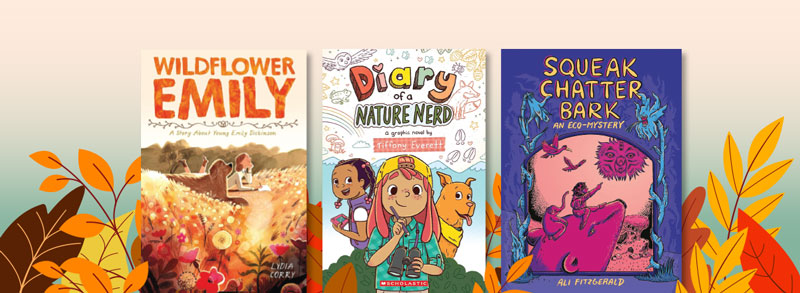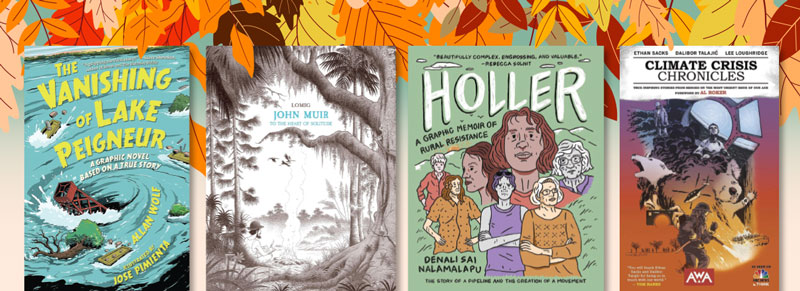7 Nature-Themed Graphic Novels to Inspire Kids to Explore the Great Outdoors
From a lushly-illustrated story of the wildflowers that inspired Emily Dickinson to vivid narratives of firefighters, researchers, and policy makers confronting climate change, these books show people engaging with the world as explorers, observers, and protectors.

 One thing graphic novels are particularly adept at is capturing people encountering the natural world. The visual aspect allows creators both to zoom in for the details of a flower or insect and zoom out on the grand sweep of mountains and oceans, sometimes on the same page. In a similar vein, each of these graphic novels depicts a different aspect of human interaction with nature, juxtaposing individual experiences with the broader picture—one that includes not only beauty and inspiration but also great dangers. From a lushly-illustrated story of how the wildflowers of western Massachusetts inspired the poems of Emily Dickinson to vivid narratives of firefighters, researchers, and policy makers dealing with climate change in their communities, these books show people engaging with the world as explorers, observers, and even protectors.
One thing graphic novels are particularly adept at is capturing people encountering the natural world. The visual aspect allows creators both to zoom in for the details of a flower or insect and zoom out on the grand sweep of mountains and oceans, sometimes on the same page. In a similar vein, each of these graphic novels depicts a different aspect of human interaction with nature, juxtaposing individual experiences with the broader picture—one that includes not only beauty and inspiration but also great dangers. From a lushly-illustrated story of how the wildflowers of western Massachusetts inspired the poems of Emily Dickinson to vivid narratives of firefighters, researchers, and policy makers dealing with climate change in their communities, these books show people engaging with the world as explorers, observers, and even protectors.
Corry, Lydia. Wildflower Emily: A Story About Young Emily Dickinson. illus. by author. Macmillan/Godwin. 2024.
Gr 3-5–Emily Dickinson wanders through fields and forests with her dog Carlo, collecting wildflowers and letting her imagination run wild in this charming book. The story shows Dickinson and her friends going to school and studying botany, providing a brief introduction to the poet and the field before following her and Carlo on a long day of gathering wildflowers and observing nature. The story is filled with whimsical touches, such as insects wearing top hats, while charming details and beautiful vistas make the artwork a true feast for the eye. Corry interweaves Dickinson’s observations with her poetry, showing how her work was inspired by what she saw around her. The book concludes with brief factual material about both Emily and Carlo.
Everett, Tiffany. Diary of a Nature Nerd. illus. by author. Scholastic/Graphix. 2025.
Gr 1-4–Nine-year-old Brooke and her best friend Jayla take a trip to North Cascades National Park in the family RV. Jayla’s father has just married Brooke’s mother, and this is a research trip for them, so the girls are free to explore their surroundings. Brooke is an experienced tracker and observer of wildlife who has already filled a diary with her findings, but she yearns to see a moose, the only animal on her wish list that she hasn’t encountered in her six years in the woods. Jayla is a novice explorer, and Brooke is happy to show her the ropes—until Jayla spots a moose when she’s out without Brooke. This causes jealousy, tension, and eventually a potentially dangerous situation between the two. As much as this graphic novel is about friendship and feelings, it’s also about respect for both the beauty and the danger of the natural world, and Brooke’s notebooks are filled with fascinating facts and reflections about the wildlife she encounters.
Fitzgerald, Ali. Squeak Chatter Bark: An Eco-Mystery. illus. by author. Fantagraphics. 2025.
Gr 3-7–A girl searches for her parents—scientists who have mysteriously disappeared—in this quixotic graphic novel set in a fanciful version of the Biosphere, an autonomous enclosed environment. Hazel, who has lived there since she was a baby, has learned to speak with animals, and her closest companion is a miniature elephant. The elephant is the first sign for readers that something is off about this place: many of the animals have been genetically engineered in odd ways, such as a turtle with a shell that absorbs plastic trash, thereby clearing the seas and making the creature worthless to turtle hunters. Hazel goes into hiding after her parents vanish, but she still keeps tabs on the human inhabitants of the biosphere, especially the director of the project, Dr. Nimick. Hazel recruits an old friend to accompany her on a journey to the heart of the troubles, bringing with them a few oddball animals and encountering more on the way. While the plot of missing parents and an evil scientist is tried-and-true, the world of the story is highly original and much of the book’s delight is found in the animal characters, such as an existentialist groundhog, a polyglot bird, and Hazel’s miniature elephant companion. Fitzgerald uses a muted palette of violet for the present-day and green for flashbacks, illustrating people and animals in a fluid style that emphasizes their personalities.

Wolf, Allan. The Vanishing of Lake Peigneur: A Graphic Novel Based on a True Story. illus. by Jose Pimienta. Candlewick. 2025.
Gr 4-7–On November 20, 1980, an oil drill broached the wall of a salt mine beneath Lake Peigneur, turning the entire lake into a massive whirlpool as all the water disappeared underground, taking with it barges, equipment, boats, and some of the land. This graphic novel uses the lake itself as a narrator, recounting the sequence of events before switching points of view between those affected by the disaster: workers in the salt mines, who barely made it out in time; two fishermen whose boat got stuck in the silty mud when the water disappeared; the captain and crew of another ship that almost got sucked into a sudden waterfall; and others. The result is a fast-paced, suspenseful story that will have readers invested from the very beginning. Wolf and Pimienta use the graphic medium at its best; for instance, explaining clearly how the geology of the lake and the salt dome beneath evolved and showing how deep the mine shafts went by comparing them to a two-story house and the Empire State Building. While the story stays focused on the humans involved, with the environmental aspect serving mostly as a background element, the back matter brings nature to the forefront with a discussion of exactly what went wrong, what happened in the aftermath, and how the need for fossil fuels will continue to drive oil drilling until their use is curbed. Wolf also cites his sources, explains the elements of the story that were fictionalized (mostly by combining characters), and gives some facts and figures about the lake and the event.
Lomig. John Muir: To the Heart of Solitude. illus. by author. NBM. 2025.
Gr 7 Up–Through excerpts from Muir’s notebooks and breathtaking drawings of the landscapes he traveled through, Lomig takes readers along on Muir’s first solo journey through the wilderness, made in 1867 when he was 28 years old. The story begins at a turning point in Muir’s life: After both of his eyes are injured in an accident at the sawmill where he works, he is confined to a dark room for two months, which gives him plenty of time to think about how he has been wasting his life at mere jobs and missing out on the beauty and profundity of nature. As soon as he recovers, he sets out on an epic trek, walking 1,000 miles from Jeffersonville, IN, through the post–Civil War South to Cedar Key, on the Gulf Coast, where he contracts malaria and has to temporarily pause his travels. After he recuperates, he travels by boat to San Francisco and sets off across the West, ending with a spiritual moment at Yosemite. Although he is walking alone much of the time, sleeping under the stars and subsisting on the simplest of diets, Muir encounters many people along the way, some hospitable, some not. He comes off as a bit preachy at times, partly because the source material is Muir’s own written text, but also because he often challenges peoples’ beliefs, particularly the notion that humans must conquer nature in order to wrest a living from it. Lomig illustrates the plants and animals in exquisite detail, shifting between delicate, detailed close-ups of leaves and flowers and panoramic landscapes that sweep across the page. His depictions of humans sometimes veer toward caricature, although the scars, bad teeth, and missing limbs as well as the poverty in which they live bears witness to the devastation of the war. Note: There is one panel in which Muir is seen nude, from the back, bathing in a mountain stream.
Nalamalapu, Denali Sai. Holler: A Graphic Memoir of Rural Resistance. illus. by author. Timber Pr. 2025.
Gr 9 Up–Six activists who worked to oppose the Mountain Valley Pipeline discuss what motivated them to take a stand and how their talents and life experiences informed their activism. While their environmentalism is rooted in their love of a single place, each one expresses it differently. A timeline of the pipeline and the campaign to fight it illustrates the concrete results of activism as well as the pipeline company’s own failures and its eventual triumph, thanks to political forces. In the final chapter of the book, Nalamalapu brings it all back to values and the importance of community while unflinchingly depicting the destruction the pipeline has caused. The art is simple, with strong lines and a limited palette dominated by soft greens. Much of the book is told in first-person testimony, but Nalamalapu keeps the visuals interesting by mixing headshots with images of natural scenes with narration captions over them.
Sacks, Ethan. Climate Crisis Chronicles. illus. by Dalibor Talajic. AWA. 2022.
Gr 9 Up–Each of the 10 chapters in this book profiles one or more individuals working in communities directly affected by climate change. Among them are a firefighter battling wildfires in California, a community activist in hurricane-struck Honduras, a photographer chronicling air pollution from coal-burning plants in China, and the mayor of Freetown, Sierra Leone, who has to deal with the realities of global warming in her own city, where houses made of corrugated iron turn into ovens and diesel fumes pollute the air. While each story focuses on a single problem in a single place, there are common themes throughout: political situations and displacement of populations due to climate change, the need for solutions that work at the local level, and most importantly, the fact that degradation of the environment affects real people and animals in very concrete ways. The final chapter focuses on an astronaut who viewed and photographed many of these phenomena—wildfires, hurricanes, deforestation—from the space station, and his reflections tie the stories together. The back matter includes a section on ways readers can take action, from simple changes such as washing clothes in cold water to a list of environmental advocacy organizations. The storytelling is spare and matter of fact, the vocabulary is high-level, and some of the stories include harsh realities of children and animals dying, but this is a truly inspirational and informative graphic novel for teen readers with an interest in global environmental issues; the individual stories open up many possible paths for exploration.

RELATED
The job outlook in 2030: Librarians will be in demand
The job outlook in 2030: Librarians will be in demand
ALREADY A SUBSCRIBER? LOG IN
We are currently offering this content for free. Sign up now to activate your personal profile, where you can save articles for future viewing






Add Comment :-
Be the first reader to comment.
Comment Policy:
Comment should not be empty !!!